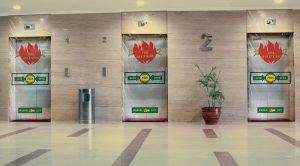— By David Dawdy —
Alternatives to elevator lobbies are a game changer for the retail and hospitality industries.
In 1980, a kitchen fire tore through the casino floor of the MGM Grand in Las Vegas. The inferno sent plumes of toxic smoke through the sprawling complex — including elevator shafts and stairwells to the floors above. Of the 85 people killed that day, 61 deaths were on the upper floors of the hotel — nowhere near the fire.

David Dowdy, Cornell Cookson
These victims, as well as the other fatalities, died of carbon monoxide poisoning and smoke inhalation. Some even perished in their sleep, completely unaware of the tragedy unfolding below. In total, nearly 650 were injured by smoke. This included 588 guests, 25 employees and two dozen firefighters.
The MGM Grand fire remains the worst disaster in Nevada history and the third worst hotel fire in American history. It also highlights the extreme danger of smoke damage, smoke inhalation and carbon monoxide poisoning due to fire.
Considering that most restaurants and hospitality spaces are on the first floor of multi-use buildings and hotel complexes, the threat of kitchen and other fires for higher level building occupants is all too real. Just look at similar stories from Russia and Japan — not to mention the high-profile Grenfell Tower Fire in London and Torch Tower fire in Dubai.
In order to protect building occupants from the threat of smoke and carbon monoxide poisoning, rolling door manufacturers have taken critical lessons from fire and life safety experts to develop code-driven solutions in the form of smoke curtains and hoistway closure systems.
Not only can these products save lives, they provide designers of hospitality spaces with more flexibility while increasing leasable space in commercial and mixed-use buildings.
The Dangers of Smoke
While the spread of fire and flames is commonly perceived to be the biggest threat to human safety, smoke and toxic gas often pose an even greater danger for building occupants. Mid- and high-rise structures typically include multiple stairways and internal elevator shafts. These enclosures and hoistways can act like a chimney or flue in a fire, allowing smoke to infiltrate otherwise safe floors of commercial and residential buildings.
Despite being protected by fire-rated, car-mounted doors, hoistway shaft openings are especially dangerous, allowing hot smoke and products of combustion to infiltrate the area. Gases can spread throughout multiple floors in a matter of minutes. The ability of smoke and hot gases to migrate quickly through unobstructed vertical shafts can result in smoke inhalation and death for those trapped on seemingly untouched or ‘safe’ floors above the fire.
To address smoke migration, the International Building Code (IBC) — beginning in 2000 — required elevator lobbies to be constructed as smoke enclosures so as to encapsulate hoistway openings on every floor of a high-rise building. A set of swinging doors at the entrance to an elevator lobby are activated during a fire event to close and seal the space, thereby minimizing smoke and gas infiltration.
While elevator lobbies have made a tremendous impact on occupant safety, they also come with significant design and facility planning drawbacks. The main issue is space. Elevator lobbies require a significant amount of square footage, especially for mixed-use building and hospitality settings where there are multiple elevator banks spread throughout a floorplan.
Not only do these elevator lobbies require unsightly swinging doors, they decrease the total amount of leasable space. This reduces the potential income for a building owner or property management company, while adding a significant amount of “dead space” in a building.
After pressure by the building and construction industry, combined with the development of innovative new products, the IBC approved the use of additional doors for hoistway openings meeting Underwriters Laboratories (UL) 1784, Smoke and Draft Control Door Assemblies, requirements in 2003.1 Manufacturers responded with new and exciting alternatives to elevator lobbies at the hoistway opening.
While the use of special coiling smoke doors as hoistway enclosures has quietly become mainstream in the design community — many hospitality and mixed-use spaces that contain restaurants, bars and retail locations still rely on traditional elevator lobbies. Thanks to new developments and options, that doesn’t have to be the case anymore.
New Options Provide Life Safety and Design Flexibility
As a result of the changes to IBC code and employment of new coiling fabric or film closures for hoistway openings, facility managers and safety experts can leverage additional square footage and create more spacious designs in lieu of constructing elevator lobbies.
Change is inevitable, and first generation hoistway closures are being eclipsed by designs that are more aesthetically pleasing by enabling the closures to be hidden within ceilings and beneath various fascia while maintaining serviceability. Finishes are now available in a variety of powder coated and stainless matching anodized finishes that will match or complement surrounding areas and aid the design professional in a professional presentation. Newer designs are functionally superior with multiple intuitive methods of operation, improved graphic details and redundant safety backup systems.
 Modern elevator hoistway closures range from semitransparent film-type materials to woven, coated fiberglass materials. The design intent is to seal hoistway openings to prevent smoke migration during a fire, allow for through-passage of car occupants, and to reseal the space if opened during an alarm event.
Modern elevator hoistway closures range from semitransparent film-type materials to woven, coated fiberglass materials. The design intent is to seal hoistway openings to prevent smoke migration during a fire, allow for through-passage of car occupants, and to reseal the space if opened during an alarm event.
While smoke curtains and closures aren’t ideal for every building or application, these innovative products can be specified and integrated into a wide variety of new and renovated hospitality and mixed-use applications.
Decades in the Making
For nearly five decades, the fire protection industry has researched smoke spread in tall buildings and sought code-based solutions. It just took changes in fire and building codes and dedication by leaders in the rolling door industry to create innovative products for elevator openings.
The integration of new materials into mechanical closure systems with the ability to withstand heat exposure has progressed rapidly in the last decade. The result is a win-win for hospitality designers, facility managers, building owners and a host of other industry professionals who want to maximize leasable space while saving lives.
Together, we can help to ensure that there will never be another tragedy like MGM Grand, Grenfell or the Torch Tower. And it will be smoke curtains and elevator shaft enclosures that help lead the charge.
1 For more information, refer Section 713, Shaft Enclosures, of the International Building Code (IBC).
— David Dawdy, director of fire and life safety new product development at Cornell-Cookson, is a 35-year veteran of the overhead door industry. Learn more at www.cornellcookson.com.
